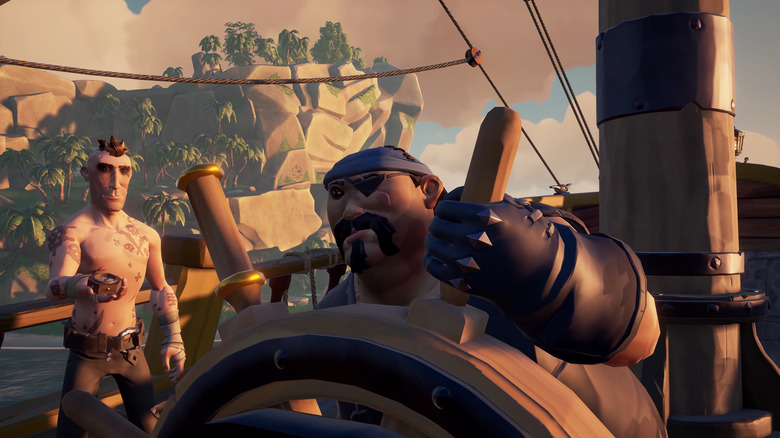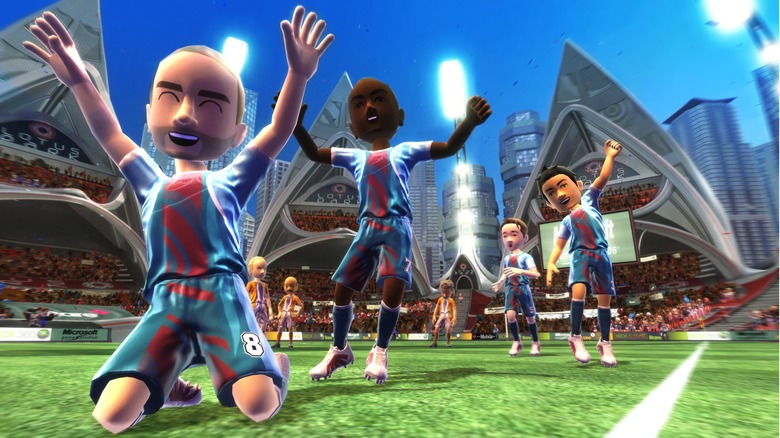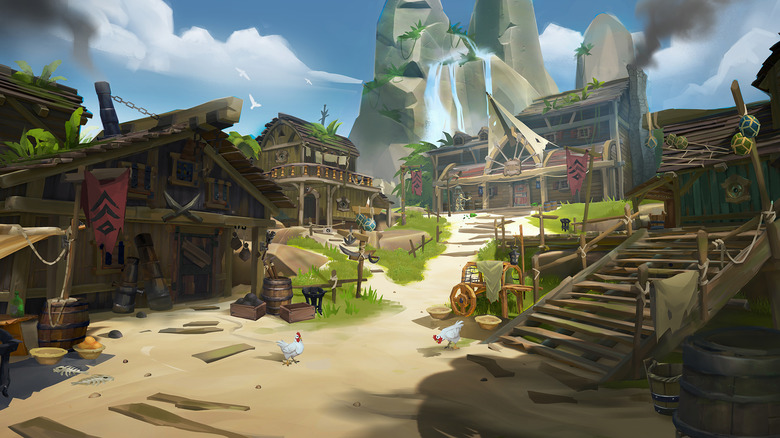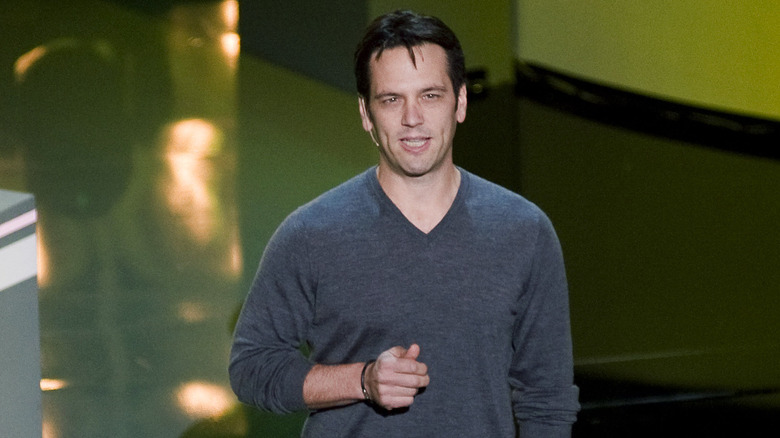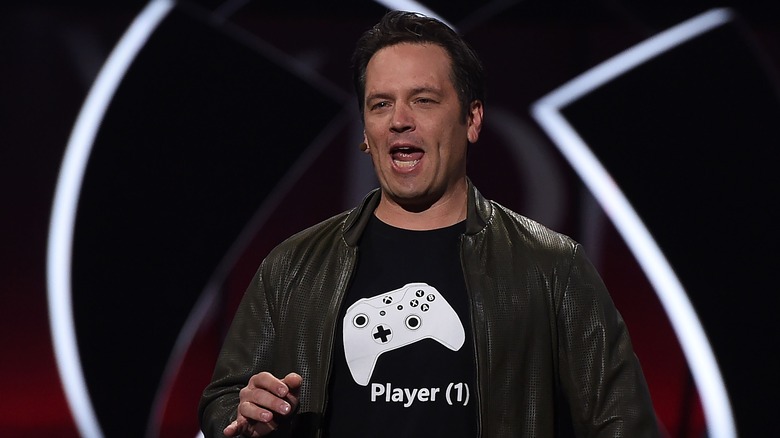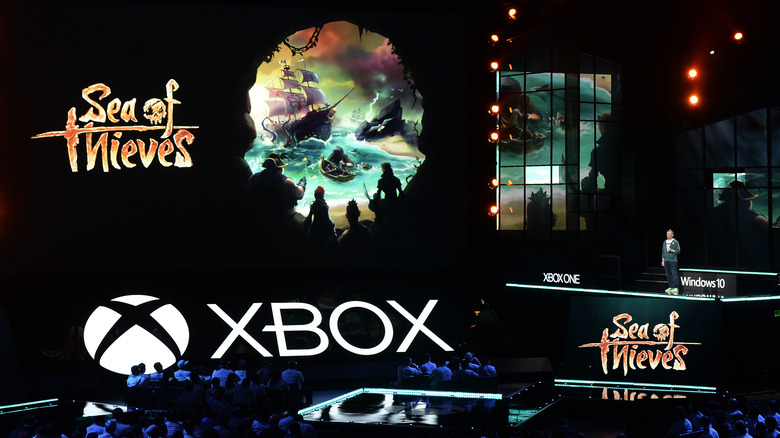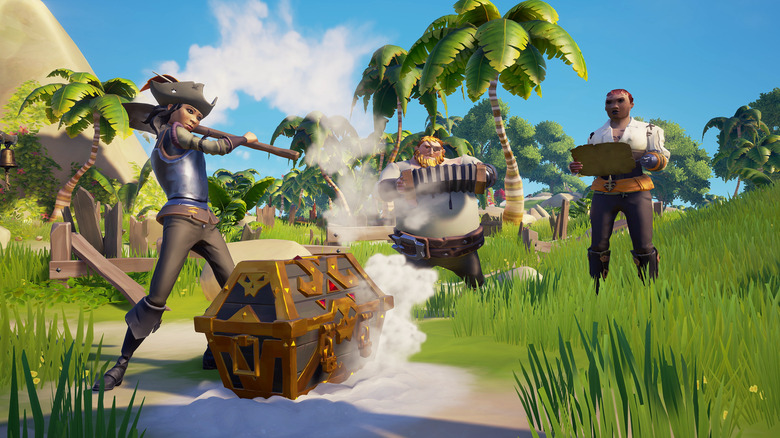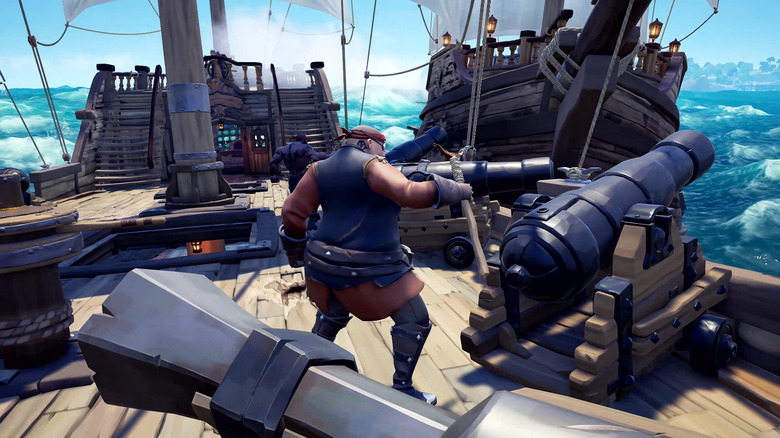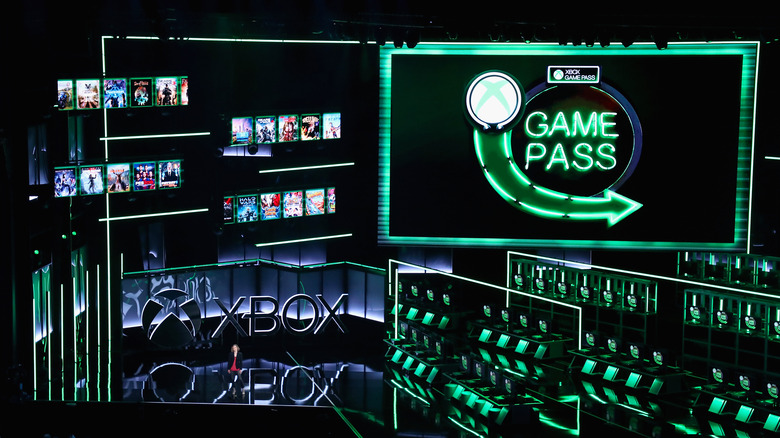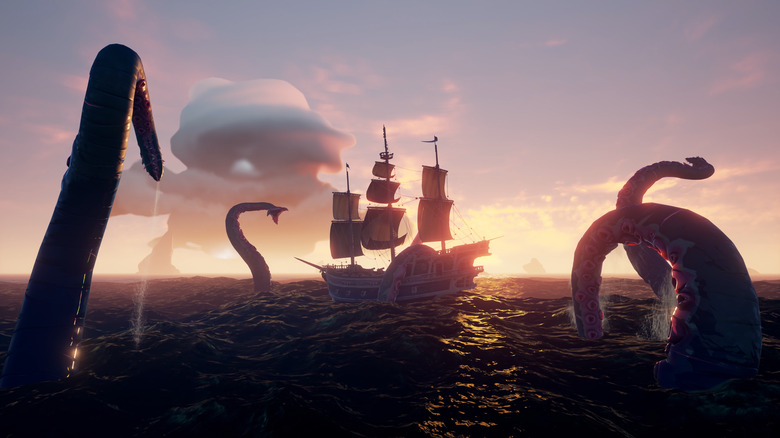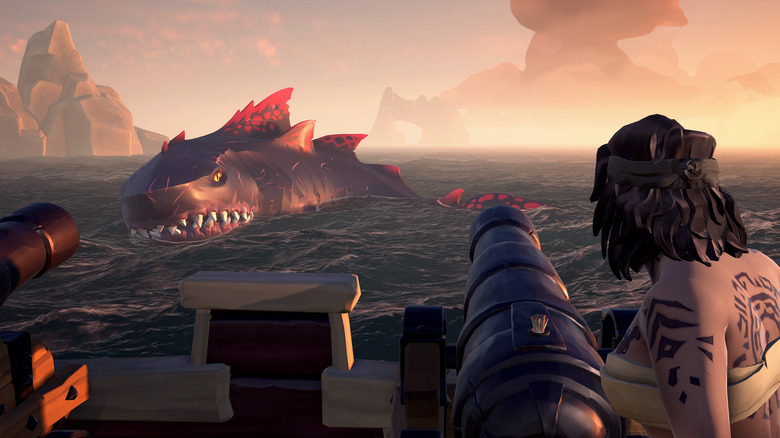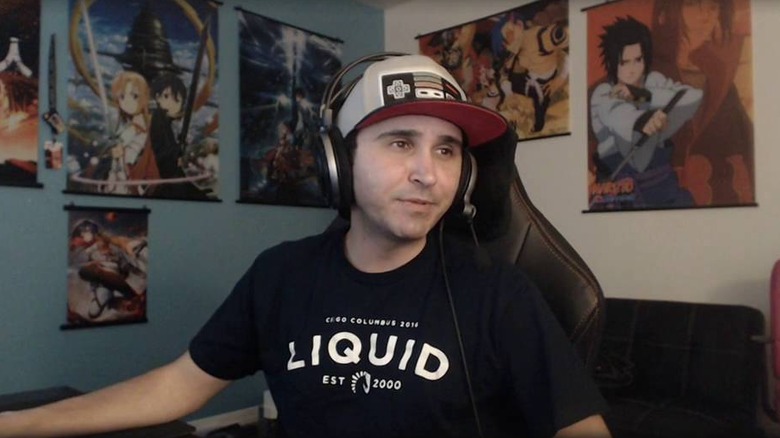The Untold Truth Of Sea Of Thieves
What a strange, fascinating, magnificent journey it's been for Sea of Thieves, the first non-Kinect game by Rare in quite some time. And what a comeback it's been for that studio — albeit, one that took some time to take shape. Once upon a time, Rare was the company you could depend on for a hit, and its resume from the 64-bit era proves as much. But in a post-Nintendo 64 world, Rare struggled to carve out a niche. It tried to rehash some older IPs. It tried to invent some new ones. Eventually, it was relegated to creating games for an accessory that once sold like hotcakes, and later, nearly killed a console.
But things are looking up.
Sea of Thieves is unlike anything Rare has ever made before. And in a lot of ways, the studio is learning as it goes, navigating the waters of supporting a game-as-a-service while trying to show the world exactly what that game is. There are plenty of shared-world shooters, with more coming. There are plenty of massively-multiplayer online RPGs. But when it comes to whimsical online pirate simulators — especially the kind with constant updates — there is exactly one. And that is Sea of Thieves.
Here is the untold truth behind it.
For a long time, Rare's talent was misused terribly
Back in the 1990s, Rare was famous for cranking out hit after hit. Who wasn't absolutely dazzled by the gorgeous graphics and challenging gameplay found in Donkey Kong Country? Who didn't play a few rounds of Killer Instinct? And who could've possibly missed out on GoldenEye 007, the best console shooter of its time?
Add those to a long list that includes Diddy Kong Racing, Jet Force Gemini, Banjo-Kazooie, Perfect Dark, and Conker's Bad Fur Day, and it's clear: Rare was a very special studio. Unfortunately, Microsoft couldn't coax a similar string of instant classics out of Rare after acquiring the company in 2002.
That's not to say Rare didn't make any well-received games. Many speak very highly of the Viva Piñata series, for instance. But more of the studio's releases were mediocre at best. And when Rare started focusing solely on the Kinect, creating experiences for that peripheral, the studio became less and less visible.
There was a feeling in the video game world that Microsoft was letting all of Rare's talent go to waste, an issue that wouldn't be addressed until the tech giant dramatically shifted directions with the Xbox One.
In early 2014, Rare came up with the concept for a new kind of game
At the beginning of 2014, one thing was abundantly clear: the Xbox One was in a bad place. The console had been poorly marketed as an all-in-one entertainment device, with Microsoft using its initial reveal to tout its TV-watching capabilities. On the gaming side, a rather regressive DRM system — one that was later ditched — hurt the console's credibility with gamers. And the mandatory inclusion of the Kinect drove the price up, making the Xbox One $100 more expensive than the PlayStation 4. Not surprisingly, all of those issues hurt the Xbox One's launch in late 2013.
Meanwhile, Rare was working hard to finish a brand new Kinect Sports title. But the writing was on the wall for the accessory. So the studio started brainstorming.
In early 2014, Rare came up with a brand new game concept — one focused on a "group shaped narrative" with "experiences that are entertaining to watch." It was bare bones as far as concepts go, but Rare thought the idea had promise. All the studio needed was a theme for the game. Oh, and for someone at the higher levels of Xbox to buy in.
Also in early 2014, Phil Spencer took over as head of Xbox
Another substantial change took place in the early days of 2014, during the Xbox One's worst days. Don Mattrick, the previous leader of the Xbox brand — and the man who famously told people that, if they didn't like the Xbox One's DRM, they should buy an Xbox 360 — left Microsoft. And Phil Spencer, who headed up Microsoft Studios at the time, stepped into an expanded role. Not only would he continue to lead Microsoft's flagship development studio, he'd also get an even bigger job title: Head of Xbox.
It didn't take long for Spencer to start rehabilitating the Xbox One's reputation.
Before long, the Kinect was an unbundled, optional accessory — one that, years later, would all but disappear. Spencer focused less on the all-in-one aspects of Microsoft's new console, instead doubling down on the gaming experiences it could provide. And a little more than a year later, Spencer came to E3 2014 with a presentation that was jam-packed with game announcements, a tradition he would carry on year after year.
It was clear that Phil Spencer — tapping into his long history of video game development at Microsoft — was looking to change the culture within the Xbox division. And in that culture, bold, new ideas could thrive.
In late 2014, a tweet from Phil Spencer put Rare back on the map
It's safe to say that the Phil Spencer era had Xbox diehards feeling better about the future of the Xbox One. Over the course of 2014, Spencer had been open and transparent about Microsoft's missteps with the console, and laid out what he intended to do in order to fix things. Much of that had to do with making the Xbox One ecosystem more desirable, whether that was through games or finding more ways to create positive connections with players. But he also had another task in front of him: developing relationships with Microsoft's first-party studios.
His visit to Rare in late 2014 got everyone particularly excited.
At that point in time, Rare was all but an afterthought. The studio had released Kinect Sports Rivals earlier in the year to very little fanfare, thanks to the gaming community's widespread dislike of the peripheral. To many, Rare had dropped off the face of the earth, and some even speculated that Microsoft would part with the studio. But one Phil Spencer tweet, stating that he'd played the latest Rare game and had a "great visit to the studio," got everyone talking.
Not only was Rare sticking around, it was working on something totally new. A "uniquely Rare game," as Spencer put it. To those familiar with the studio's history, this was very good news.
Sea of Thieves had ups and downs at E3
Over a year after the studio's last release, we finally got our first look at Rare's next title. It happened at E3 2015, and it wasn't much, but it gave us a good idea of the direction Rare was headed. Think shared-world, kind of like Destiny, but with pirates. Also, do away with the traditional campaign structure found in most games, and think about what it would be like to make your own fun.
That was Sea of Thieves in a nutshell.
The game's debut in 2015 showed a lot of promise, but again, didn't offer much to chew on. At E3 2016, however, attendees got some hands-on time with the game, and most absolutely loved what they experienced. Those who weren't sold at the game at the previous E3 suddenly were, and it appeared that Rare had a winner on its hands.
Then E3 2017 rolled around, and the highs returned to lows once more. The game got delayed (something that's become a staple of Microsoft titles) out of 2017 and into 2018. And suddenly, all of the good vibes surrounding the game (and the Xbox One at the time) dissipated. The delay didn't set a very good tone for Sea of Thieves' eventual release. And that tone stuck.
Sea of Thieves launched in March 2018 to very mixed reviews
Sea of Thieves might have gotten by as a skeleton of a game (no pun intended) if it had come out on time. If it hadn't been lapped by so many other interesting online games, players might have been willing to look past the fact that the game didn't just eschew structure — it asked everyone to goof off in a world that didn't have much to see or do. Instead, everyone saw through what Sea of Thieves had to offer at its launch, which wasn't much. A short E3 play session might have been incredibly fun. But it didn't scale.
The reviews for Sea of Thieves weren't all that hot, as a result.
"Sea of Thieves has the foundation of an incredible experience," wrote Polygon's Russ Frushtick. "It is a true pirate game that simulates the experience of piracy perfectly. And yet, after those first few jaw-dropping hours, you're going to start feeling less like Blackbeard and more like Blackbeard's accountant.
There were pirates. There were ships. There was treasure. But there was no reason to keep playing. The Sea of Thieves squad had some work to do.
The first Pirate Legend achieved that title under dubious circumstances
The unfavorable press for Sea of Thieves didn't stop at its reviews, either. Because while there may not have been a whole lot to progress toward in the game, there was one rare milestone that many players were racing toward: the title of Pirate Legend. In order to reach Pirate Legend, players had to hit max level with each of the game's three factions — a process that, for whoever wanted it first, would require many consecutive hours of play.
Unless you did what Prod1gyX, the first Pirate Legend, did. He used his Twitch community to significantly shorten his grind.
Basically, Prod1gyX worked with those who watched him on Twitch to "boost," sending them around the Sea of Thieves world gathering treasure on his behalf. Hunting down treasure is a time-consuming endeavor, so to many critics, Prod1gyX took a shortcut by having progress delivered to him, instead of going out and playing the game himself. Many used the hashtag #NotMyPirateLegend to discount Prod1gyX's accomplishment, instead crowning a different player — SniperNamedG — as the real first Legend.
But Prod1gyX saw no harm in what he did.
"I'm not here to satisfy you," he said. "I'm here to satisfy my community."
The game was one of the first to launch directly into Xbox Game Pass
In Sea of Thieves' early days, the lack of content in the game — paired with so-so reviews — didn't give players a lot of incentive to purchase the game at its full $60 price point. Still, Sea of Thieves sold rather well. Producer Joe Neate told USGamer that Sea of Thieves "had a target to hit by the end of June [2018]" and actually managed to hit that target the first day the game was on sale.
It appears that much of the credit has to do with the fact that Sea of Thieves was one of Microsoft's first exclusives to launch directly into Xbox Game Pass, the company's all-you-can-play subscription service.
When Sea of Thieves first released, players could sign up for a ten-day trial of Xbox Game Pass, which helped bolster the game's numbers. "We saw really high conversion of people who came in, played Sea of Thieves, and then either bought the game or signed up to Game Pass," Neate said.
Without the Game Pass trial, or a Game Pass subscription existing to keep the player count up, there's a chance that Sea of Thieves could've been sunk. Instead, the team behind it got an opportunity to keep sailing.
Rare added expansions and more free content for the game
Sea of Thieves started out a little scant. Just about anyone who played the game will admit as much, and Rare might, as well. It launched as so many games-as-services do: with the promise that it would be a living, breathing product that improved over time, adding new ways to play and new content to explore.
And to Sea of Thieves' credit, it delivered as much, and perhaps did more than other games typically do. In 2018 alone, the game added four expansions. And they were all free.
Things kicked off in the summer of 2018 with The Hungering Deep, which wasn't all that substantial in the grand scheme. It introduced a small campaign, some new cosmetics, and added a large new creature to the game's dangerous waters. But it didn't stop there. Cursed Sails came a short time later, and added a new threat in AI-controlled skeleton ships and whole bunch of new world activities and rewards. Forsaken Shores arrived in September 2018 to offer the largest expansion to date, with another story campaign, a whole new map area to visit, cargo runs (a new type of mission), and another ship for sailing the seas. And finally, Shrouded Spoils came later in the fall with more ways for players to customize their ships, more end-game content, and more loot.
And Rare still isn't done. More is on the way.
Rare issued an usual update in 2019 that required players to uninstall the game
In most cases, the purpose of a post-launch patch is to make the game better. And the entire point of a patching system is to ensure that the game can be made better without having to install an entirely new version. That's the beauty of the internet, right? It means that a shipped game doesn't always have to be broken. A quick patch can fix things up.
For Sea of Thieves, however, an update in early 2019 broke that rule entirely. It was actually to the benefit of Sea of Thieves' player base, in a way. But it was highly unusual.
Thanks to the game's many expansions and updates in 2018, the install size of Sea of Thieves was growing a tad unwieldy. For this reason, the team at Rare had worked on a way to bring the game's total install size down so that it ultimately took up less space. Unfortunately, taking advantage of this more streamlined version of Sea of Thieves meant that players had to essentially re-download and reinstall the game entirely.
That's a big ask for a live game that relies on people having the game installed and ready to play. Fortunately, it doesn't look like the update was all that harmful to Sea of Thieves' player base.
Sea of Thieves experienced a resurgence thanks to Twitch
Something kind of incredible happened with Sea of Thieves in early 2019, and it's something that not a lot of live service games get to experience. Usually, if a game comes out at launch, the odds of people coming back to give it a second chance are very slim. There are so many other things to play, after all. Something has to really improve to re-catch a player's eye. Yet it can be done. Just ask Rainbow Six: Siege.
Sea of Thieves had that type of comeback in 2019, as players realized that the game had changed dramatically since it launched the previous year. And it had gotten a lot better.
The Sea of Thieves renaissance can largely be credited to major Twitch streamers, such as Summit1g, who found himself really enjoying the game, taking his enormous community along for the ride. Soon, many other streamers had joined him. The ripple effect of suddenly becoming a Twitch phenomenon got a bunch of lapsed Sea of Thieves players — and many new ones — to jump back in and experience all of the new content that had been added in the previous months. And just like that, Sea of Thieves was back.
The grip Sea of Thieves had on Twitch has loosened now, mostly because of streamer-friendly games like Apex Legends. But the game is still performing better than it was, which is good news — both for Sea of Thieves and for its players.

